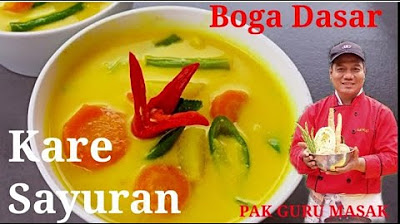Easy Authentic Thai Green Curry At Home
Summary
TLDRThis video takes you through the process of making an authentic Thai green curry from scratch, focusing on the vital step of creating homemade green curry paste using a mortar and pestle. The recipe emphasizes the importance of fresh, aromatic ingredients like galangal, lemongrass, and kaffir lime leaves. The video guides viewers step-by-step, showing how to balance flavors with the perfect combination of chicken, vegetables, and coconut milk. The result is a vibrant, fragrant curry that brings the full depth of Thai cuisine to life, with an invitation to embrace the effort for truly exceptional flavor.
Takeaways
- 😀 The best Thai green curry requires making curry paste from scratch using a mortar and pestle, not store-bought paste.
- 🌿 Fresh ingredients like galangal, lemongrass, cilantro stems, and kaffir lime leaves are essential for authentic flavor.
- 🔥 The key to great curry paste is grinding each ingredient by hand to release their full aromatic potential.
- 🍛 Making the curry paste from scratch may take 15-20 minutes but the flavor payoff is worth it.
- 💡 Using a mortar and pestle over a blender prevents damaging your blender and ensures a smoother paste.
- 🥘 The curry paste should be cooked down in oil until it sticks to the pan and becomes aromatic before adding other liquids.
- 🍗 Chicken thighs are the best choice for this curry as they stay tender and juicy when cooked.
- 🍚 Serve the curry with steamed short-grain rice and garnish with fried shallots, Thai basil, and fresh chili for extra flavor.
- 🍋 Adjust the flavor of the curry with lime juice, fish sauce, and palm sugar to taste, depending on your preferences.
- 🥢 The curry can be customized with vegetables like eggplants and snow peas, but the balance of flavors is key for perfection.
Q & A
Why is it important to make your own curry paste instead of using store-bought?
-Making your own curry paste ensures a fresh, flavorful, and aromatic curry. Store-bought versions are typically less vibrant and don't offer the same depth of flavor. The effort of grinding the ingredients by hand enhances the taste and creates a more authentic curry experience.
What ingredients are essential for making the Thai green curry paste?
-The essential ingredients for the green curry paste include coriander seeds, cumin seeds, white peppercorns, Thai chilies, Serrano chilies, shallots, garlic, cilantro stems (not leaves), lemongrass, galangal, kaffir lime leaves, lime zest, and dried Thai shrimp paste.
Can I substitute ginger for galangal in the curry paste?
-No, galangal is key for the authentic flavor of Thai green curry. Ginger has a different taste profile and won't replicate the distinctive aroma and taste that galangal provides.
How long does it take to grind the curry paste by hand?
-It takes approximately 15 to 20 minutes of grinding to achieve a smooth and cohesive curry paste. This process requires patience and effort, but the resulting flavor is worth it.
What happens if I don’t grind the ingredients finely enough?
-If the ingredients are not ground fine enough, the curry paste won't blend smoothly into the sauce, and you may notice visible seeds or uneven texture. Grinding them finely allows for a smoother and more integrated curry.
Why do I need to toast the spices before grinding them?
-Toasting the spices brings out their essential oils, deepens their flavor, and enhances the aroma, which results in a more complex and rich curry paste.
How do I know when the curry paste is ready for cooking?
-The curry paste is ready when it forms a smooth ball that holds together. If you can form a ball with the paste without it falling apart, it's sufficiently ground and prepared for cooking.
What type of chicken should I use in this curry recipe?
-Boneless and skinless chicken thighs are recommended because they are tender, juicy, and absorb the curry's flavor well. Cut the chicken into small 1/2-inch cubes for even cooking.
How can I adjust the spice level in the curry?
-To adjust the spice level, you can control the number of chilies you use in the paste. Thai green curry can be spicy, but once combined with the other ingredients like coconut milk and sugar, it becomes more balanced. If you prefer a milder curry, use fewer chilies.
What should I do if my curry tastes too sour or too sweet?
-If your curry is too sour, add a little more palm sugar to balance the flavor. If it's too sweet, you can adjust by adding more fish sauce to enhance the savory and salty notes. Always taste and adjust to your preference.
Outlines

Dieser Bereich ist nur für Premium-Benutzer verfügbar. Bitte führen Sie ein Upgrade durch, um auf diesen Abschnitt zuzugreifen.
Upgrade durchführenMindmap

Dieser Bereich ist nur für Premium-Benutzer verfügbar. Bitte führen Sie ein Upgrade durch, um auf diesen Abschnitt zuzugreifen.
Upgrade durchführenKeywords

Dieser Bereich ist nur für Premium-Benutzer verfügbar. Bitte führen Sie ein Upgrade durch, um auf diesen Abschnitt zuzugreifen.
Upgrade durchführenHighlights

Dieser Bereich ist nur für Premium-Benutzer verfügbar. Bitte führen Sie ein Upgrade durch, um auf diesen Abschnitt zuzugreifen.
Upgrade durchführenTranscripts

Dieser Bereich ist nur für Premium-Benutzer verfügbar. Bitte führen Sie ein Upgrade durch, um auf diesen Abschnitt zuzugreifen.
Upgrade durchführenWeitere ähnliche Videos ansehen

HOW TO MAKE JAPANESE CURRY WITHOUT USING CURRY CUBES

GURIH BANGET ! RESEP MIE ACEH

Cara Membuat KARE SAYURAN Pembelajaran Bumbu Kuning Boga Dasar

Thai Food Safari | Thai Cuisine

Nagpur Special Saoji Chicken Curry Authentic Recipe, Spicy Saoji Chicken, झणझणीत साओजी चिकन,

Indian Food Safari | Indian Cuisine
5.0 / 5 (0 votes)
